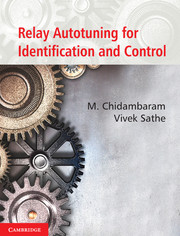Book contents
- Frontmatter
- Contents
- List of Figures
- List of Tables
- Acknowledgements
- Preface
- 1 Introduction
- 2 Improved Autotune Identification Methods
- 3 Cascade Controllers Tuning by Relay Autotune Method
- 4 Simultaneous Relay Autotuning of Cascade Controllers
- 5 A Simple Method of Tuning Cascade Controllers
- 6 Improved Saturation Relay Test for Systems with Large Dead Time
- 7 Identification of FOPTD Model using Single Symmetrical Relay Test
- 8 Autotuning of PID Controllers for Unstable FOPTD Systems
- 9 Autotuning of PID Controllers for Critically Damped SOPTD Systems
- 10 Estimation of SOPTD Transfer Function Model
- 11 Estimation of Five Parameters of Unstable SOPTD Model with a Zero
- 12 Identification of FOPTD Multivariable Systems
- 13 Identification of SOPTD Multivariable Systems
- 14 Tuning of Multivariable Controllers for Non-Minimum Phase Systems
- 15 Tuning of Multivariable Controllers by Genetic Algorithms
- 16 Summary and Conclusions
- Appendix A
- Appendix B
- Appendix C
- Nomenclature
- Problems
- Suggestive Reading
- References
- Index
16 - Summary and Conclusions
Published online by Cambridge University Press: 05 June 2014
- Frontmatter
- Contents
- List of Figures
- List of Tables
- Acknowledgements
- Preface
- 1 Introduction
- 2 Improved Autotune Identification Methods
- 3 Cascade Controllers Tuning by Relay Autotune Method
- 4 Simultaneous Relay Autotuning of Cascade Controllers
- 5 A Simple Method of Tuning Cascade Controllers
- 6 Improved Saturation Relay Test for Systems with Large Dead Time
- 7 Identification of FOPTD Model using Single Symmetrical Relay Test
- 8 Autotuning of PID Controllers for Unstable FOPTD Systems
- 9 Autotuning of PID Controllers for Critically Damped SOPTD Systems
- 10 Estimation of SOPTD Transfer Function Model
- 11 Estimation of Five Parameters of Unstable SOPTD Model with a Zero
- 12 Identification of FOPTD Multivariable Systems
- 13 Identification of SOPTD Multivariable Systems
- 14 Tuning of Multivariable Controllers for Non-Minimum Phase Systems
- 15 Tuning of Multivariable Controllers by Genetic Algorithms
- 16 Summary and Conclusions
- Appendix A
- Appendix B
- Appendix C
- Nomenclature
- Problems
- Suggestive Reading
- References
- Index
Summary
This work focuses attention on (i) incorporation of higher order harmonics in the analysis of relay tuning of controllers for a single loop controller, cascade control systems, single loop saturation relay test, single loop unstable FOPTD system and single loop stable SOPTD system; (ii) providing a simple method of designing P/PI controllers for cascade control schemes; (iii) estimation of model parameters of unstable FOPTD, stable SOPTD and unstable SOPTDZ systems using a single relay feedback test and (iv) application to multivariable systems.
Improved Autotune Identification Method
A method is suggested to formulate an additional equation so that the process gain can also be estimated using the conventional relay autotune method. This method avoids getting a negative time constant of an FOPTD model. For systems showing higher order harmonics in the response, a modification of the calculation for the model parameters of FOPTD model using the conventional relay feedback method is also proposed. This method does not assume the complete filtering of higher order harmonics. The method of calculation is also simple. The present method gives an improved value for the controller ultimate gain. The method gives a more accurate result [on ku and on the identified FOPTD model parameters] than that proposed by Luyben (1987) and Li et al. (1991). Simulation results show that the present method gives improved open loop as well as closed loop performances.
The proposed modification in the asymmetrical relay test gives improved values of the parameters of the FOPTD model.
- Type
- Chapter
- Information
- Relay Autotuning for Identification and Control , pp. 206 - 214Publisher: Cambridge University PressPrint publication year: 2014



